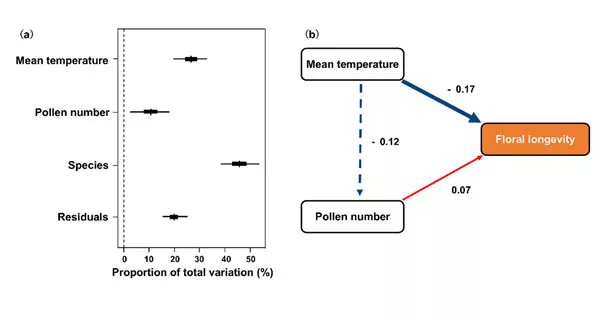The reporter learned from Kunming Institute of Botany, Chinese Academy of Sciences on the 28th that the Institute has made important progress in the biogeographic pattern of flower life and evolutionary adaptation. It is found that: under the background of continuous global warming and the frequent occurrence of extreme high temperature events, the flower life of plants may show a trend of shortening, which will aggravate the lack of pollination and cause changes in plant population or geographical distribution**

(a) The contribution of temperature, pollen number and phylogenetic relationship to the variation of flower life span; (b) A structural equation model for the effect of temperature and pollen number on flower longevity
Flowers, since ancient times, have been the transmitter of aesthetic love; As far as plants are concerned, flowers are an essential organ for population continuation. The duration of a flower from opening to metabolism is called flower longevity, which is an important reproductive trait of plants. The flower life span of plants shows great differences, some are "short-lived" for a few hours, while others can bloom slowly for tens of days. Even among different cohabitation groups of the same family, genus or species, flower life span showed various changes. Since the botanist Kerner von marilaun first paid attention to the huge difference of plant flower life in 1895, the ecological and evolutionary adaptation mechanism of flower life has always been the focus of plant evolutionary biologists. However, there is still a lack of systematic understanding of the biogeographic pattern of plant flower life and its influencing factors.
Researchers from the alpine plant diversity research team of Kunming Institute of Botany, Chinese Academy of Sciences collected data on flower life span of 818 angiosperms around the world, and discussed "what is the global biogeographic pattern of flower life span?" "What factors control flower life?" And other scientific issues.
Among all angiosperms investigated, the average flower life span was 4.5 days, of which the shortest was only 2 hours and the longest was 33 days, with a difference of 400 times; The flower life span has a strong phylogenetic signal, indicating that the closer the relationship between plants, the more similar the flower life span; With the increase of latitude and altitude, the average flower life near the equator is 2 days, while the average flower life at 50 degrees north latitude and 50 degrees south latitude is 4.9 days and 3.9 days respectively; Different from the traditional view, the flower life of self incompatible plants, herbaceous plants, insect pollinators and large flowered plants is not longer than that of self compatible plants, woody plants, vertebrate pollinators and small flowered plants; The more pollen each flower produced or the lower the pollination success index, the longer the flower life; In high temperature, drought and strong solar radiation areas, plants tend to have short flower life. When all biological and abiotic factors are considered at the same time, only the temperature (negative correlation) and pollen quantity (positive correlation) in the flowering season have a significant impact on the flower life, explaining 26% and 10% of the variation respectively, indicating that the plant flower life is mainly affected by the temperature of the environment.
This study makes up for the change pattern of flower life span on the macro scale, and systematically reveals what factors affect flower life span. As temperature related physiological costs (such as respiration and transpiration) are the main determinants of flower life, under the background of continuous global warming and the frequent occurrence of extreme high temperature events, the flower life of plants may show a trend of shortening, which will exacerbate the lack of pollination and cause changes in plant population or geographical distribution. The results provide a reference for the protection of plant diversity under global climate change.
The relevant research was recently published in the International Journal of Botany, new Phytologist, with the title of global analysis of floral longevity reviews latitudinal gradients and biological and abiotic correlates.